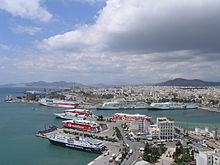Harbor: Difference between revisions
Denisarona (talk | contribs) m Reverted edits by 59.94.233.152 (talk) to last version by Some standardized rigour |
No edit summary |
||
| Line 12: | Line 12: | ||
==Natural harbors== |
==Natural harbors== |
||
[[Image:930218630 a6a5d892d0 o.jpg|thumb|A natural harbor |
[[Image:930218630 a6a5d892d0 o.jpg|thumb|A natural harbor ipart of a [[body of water]] is protec |
||
A natural harbor is a [[landform]] where a part of a [[body of water]] is protected and deep enough to furnish anchorage. Many such harbors are [[ria]]s. Natural harbors have long been of great [[military strategy|strategic naval]] and [[economic]] importance, and many great cities of the world are located on them. Having a protected harbor reduces or eliminates the need for breakwaters as it will result in calmer waves inside the harbor. For example is [[Subic]], [[Zambales]] in the [[Philippines]]. |
|||
==Ice-free harbors== |
==Ice-free harbors== |
||
For h |
|||
bors near the [[geographical pole|North and South Poles]], being ice-free is an important advantage, especially when it is year-round. Examples of these include [[Murmansk, Russia]]; [[Pechenga, Russia]], formerly Petsamo, [[Finland]]); [[Vladivostok, Russia]]; [[St. Petersburg, Russia]]; [[Hammerfest|Hammerfest, Norway]]; [[Vardø, Norway]]; and [[Prince Rupert Harbour]], [[Canada]]. The world's southmost harbor, located at Antarctica's [[Winter Quarters Bay]] (77° 50′ South), is potentially ice-free, depending on the summertime [[pack ice]] conditions.<ref>[http://www.nsf.gov/about/budget/fy2000/00OPP.htm U.S. Polar Programs] National Science Foundation FY2000.</ref> |
|||
==Important harbors== |
==Important harbors== |
||
Revision as of 11:54, 5 December 2011

A harbor or harbour (see spelling differences), or haven, is a place where ships, boats, and barges can seek shelter from stormy weather, or else are stored for future use. Harbors can be natural or artificial. An artificial harbor has deliberately-constructed breakwaters, sea walls, or jettys, or otherwise, they could have been constructed by dredging, and these require maintenance by further periodic dredging. An example of the former kind is at Long Beach Harbor, California, and an example of the latter kind is San Diego Harbor, California, which was, under natural conditions, too shallow for modern merchant ships and warships.
In contrast, a natural harbor is surrounded on several sides by prominences of land. An example of this kind of harbor is San Francisco Bay, California.
Harbors and ports are often confused with each other. A port is a facility for loading and unloading vessels; ports are usually located in harbors.
Artificial harbors
Artificial harbors are frequently built for use as ports. The largest artificially created harbor is Jebel Ali in Dubai.[1] Other large and busy artificial harbors are located in: Rotterdam, The Netherlands; Houston, Texas; Long Beach, California; and San Pedro, California.
Natural harbors
[[Image:930218630 a6a5d892d0 o.jpg|thumb|A natural harbor ipart of a body of water is protec
Ice-free harbors
For h bors near the North and South Poles, being ice-free is an important advantage, especially when it is year-round. Examples of these include Murmansk, Russia; Pechenga, Russia, formerly Petsamo, Finland); Vladivostok, Russia; St. Petersburg, Russia; Hammerfest, Norway; Vardø, Norway; and Prince Rupert Harbour, Canada. The world's southmost harbor, located at Antarctica's Winter Quarters Bay (77° 50′ South), is potentially ice-free, depending on the summertime pack ice conditions.[2]
Important harbors
[[Image:harbour.clovelly.arp.750pix.jpg|thumb|right|The tiny harbor at the village of Clovelly, Devon, England]]



Although the world's busiest port is a hotly contested title, in 2006 the world's busiest harbor by cargo tonnage was the Port of Shanghai.[3]
The following are large natural harbors:
- Hai Phong Port, Haiphong, Vietnam
- Amsterdam, Port of Amsterdam, Netherlands
- Antwerp, Port of Antwerp, Flanders, Belgium
- Bacolod City, Negros Occidental, Philippines
- Baltimore's Inner Harbor, Maryland, United States
- Boston Harbor, Massachusetts, United States
- Bremerhaven, Germany
- Buenos Aires, Argentina
- Cartagena, Colombia
- Charleston, South Carolina, United States
- Cork Harbour, Ireland
- Duluth, Minnesota, United States
- Durban, South Africa
- Falmouth, Cornwall, England, United Kingdom
- Visakhapatnam, Andhra Pradesh, India
- Freetown Harbour, Sierra Leone
- Golden Horn, Istanbul, Turkey
- Izmir's Inner Harbor, Izmir, Turkey
- Gothenburg, Sweden
- Grand Harbour, Malta
- Halifax Harbour, Nova Scotia, Canada
- Hamburg Harbour, Germany
- Hampton Roads, Norfolk, Virginia, United States
- Karachi, Sindh, Pakistan
- Kingston, Jamaica
- Kobe Harbour, Kobe, Japan
- Kochi, India
- Lushunkou, Dalian, China
- Mahon, Minorca, Spain
- Manila Bay, Philippines
- Milford Haven, Wales, United Kingdom
- Montevideo, Uruguay
- Mumbai, India
- Nassau, Bahamas
- New York Harbor, United States
- Oslofjord, Norway
- Pearl Harbor, Honolulu, Hawaii, United States
- Piraeus, Attiki, Greece
- Plymouth Sound, Devon, England, United Kingdom
- Poole Harbour, Dorset, England, United Kingdom
- Port Jackson, Sydney, New South Wales, Australia
- Port of Tyne, Tyne & Wear, United Kingdom
- Port Phillip, Victoria, Australia
- Rio de Janeiro, Guanabara Bay, Brazil
- Rotterdam, Port of Rotterdam, Netherlands
- Salvador, Brazil
- San Diego Bay, San Diego, California, United States
- San Francisco Bay, California, United States
- Sankt Petersburg, Russia
- Sevastopol Harbour, Sevastopol, Ukraine
- Tanger-Med, Tangier, Morocco
- Tauranga Harbour, Tauranga, New Zealand
- Tokyo Bay, Tokyo, Japan
- Trincomalee, Sri Lanka
- Vancouver, Canada
- Victoria Harbour, Hong Kong
- Chennai port, India
- Vizhinjam, India
- Wellington Harbour, New Zealand
- Willemstad, Curaçao, Netherlands Antilles
Other notable harbors include:
- Belém, Brazil
- Kahului, Hawaii, United States
- Kaipara Harbour, New Zealand
- Kaohsiung, Taiwan
- Keelung, Taiwan
- Kilindini Harbour, Kenya
- Keppel Harbour, Singapore
- Manukau Harbour, Auckland, New Zealand
- New Haven Harbor, Connecticut, United States
- Port of Bruges-Zeebrugge, Flanders, Belgium
- Port of Genoa, Italy
- Portland Harbour, Dorset, England, United Kingdom
- Rades, Tunisia
- Trondheim, Norway
- Port of Gdańsk, Poland
- Port of Szczecin, Poland
See also
Notes
- ^ Hattendorf, John B. (2007), The Oxford encyclopedia of maritime history, Oxford University Press, p. 590, ISBN 9780195130751
- ^ U.S. Polar Programs National Science Foundation FY2000.
- ^ AAPA World Port Rankings 2006
